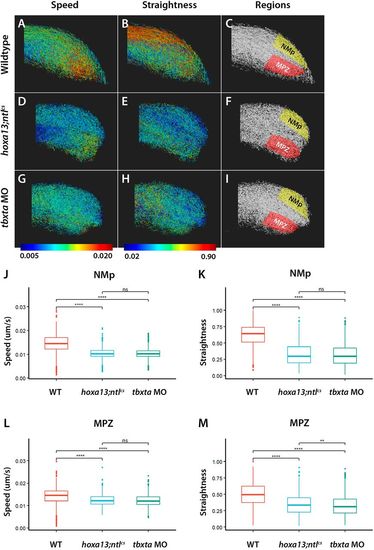Fig. 6
- ID
- ZDB-FIG-210205-30
- Publication
- Ye et al., 2020 - hox13 genes are required for mesoderm formation and axis elongation during early zebrafish development
- Other Figures
- All Figure Page
- Back to All Figure Page
|
hoxa13;ntlcs mutants and tbxta morphants have similar posterior cell movements. (A-I) Embryos expressing nuclear EGFP were filmed at the posterior end. Tracks from a representative embryo are shown in each panel, with the lowest speed or straightness shown in blue and the highest in red. The regions used for quantitative analysis are shown on the right, with the NMps and mesodermal progenitor zone (MPZ) illustrated. Note the similar shapes of the tailbuds of hoxa13;ntlcs mutants and tbxta morphants (tbxta MO) compared with wild type. (J-M) Graphs of speed (J,L) and straightness (K,M) obtained from analysis of 1193, 1295 and 1396 tracks from the NMps and 1173, 1273 and 1399 tracks from the MPZ of three wild-type, hoxa13;ntlcs mutant and tbxta morphant embryos, respectively. Straightness is the displacement divided by the track length; a value of 1.0 indicates movement in a perfectly straight direction, whereas a value of 0.0 indicates no displacement from the origin. Dunn's test was used for multiple comparisons of mean speed and straightness. **P<0.01; ****P<0.001; ns, no significant difference (P>0.05). |

